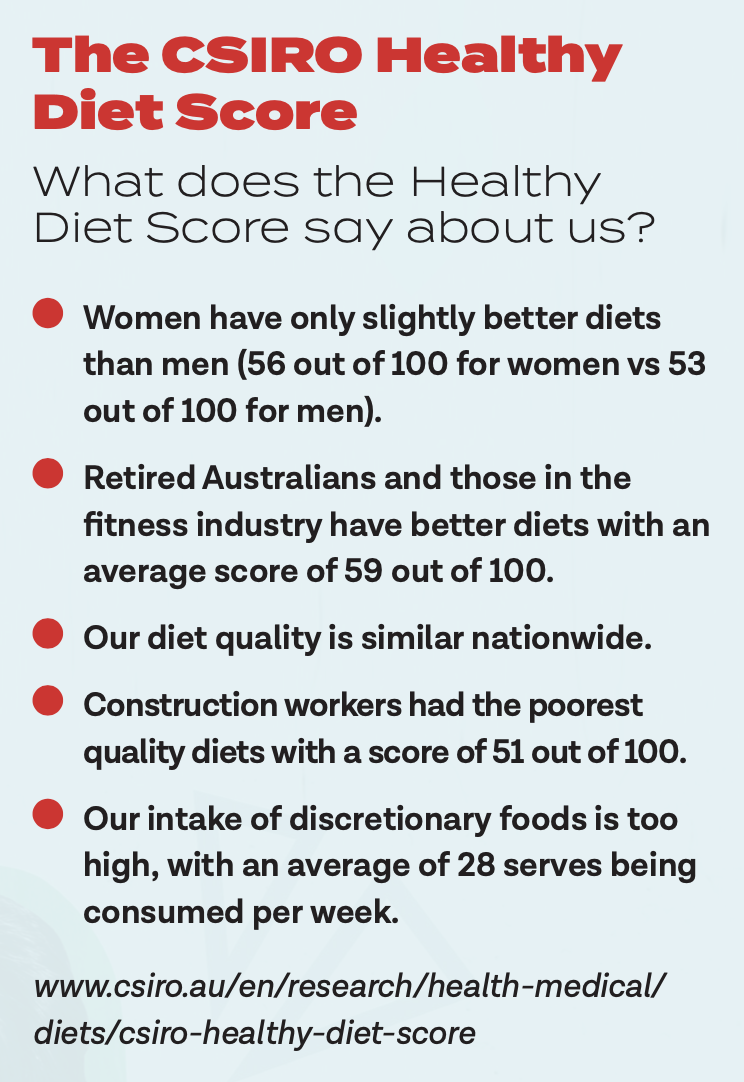There are many reasons behind our individual food choices, but comparing those decisions to the recommendations can be a good way to start making healthy changes. MYKE BARTLETT writes.
Dr Gilly Hendrie has been tracking Australia’s dietary habits for the best part of a decade and, sadly, the news isn’t good. Last year the report from the CSIRO’s Healthy Diet Score survey suggested that Australian diets are – overall – getting worse, with a majority not eating the recommended number of vegetables. As a senior research scientist for CSIRO, Gilly is one of the co-authors of the most recent report. She says the reasons for Australia’s slide away from healthy eating are many and complex.
“When we look at food choice, convenience and health costs, all these things drive what we eat,” Gilly says. “Particularly at the moment, there’s a lot of attention on cost. We’re also time poor as a population and therefore people turn to convenience.”
Although many Australians do choose food based on its healthiness, cheapness and convenience can often outweigh health as a factor. But no two people will make the same decisions, given the range of external influences, resources and knowledge that can inform what we eat.
“There’s a whole ecosystem around what we eat – what’s happening in our families, in our homes, in the community around us, in the school environment, all the way up to what’s happening at the government level around policy. There’s a range of factors.”
The recent report suggests that a perceived lack of time is a major factor. Retirees – those Australians likely to have most leisure time – tend to be eating most healthily.
But what does it actually mean to eat healthily? Although fad diets come and go, Gilly says the core elements of healthy eating remain pretty constant.
“Whether it’s the Mediterranean diet or the CSIRO total wellbeing diet, the majority of meals are made up of fresh fruit and veg and whole grains with lean protein, whether it’s soy, meat or dairy. If you look at your plate for every meal and go, well, the majority of this is coming from those core healthy food groups that give me a lot of nutrients, then that’s the foundation of a good diet.”
Switching food groups doesn’t mean having to abandon the foods you enjoy. When it comes to healthy eating, variety is key.
Where Australians are increasingly failing on their healthy diet score is eating too little from the core healthy food groups and too much from the discretionary food groups. Discretionary foods are those which are high in saturated fats, sugars, salts or alcohol and which tend to be energy dense. Putting fewer of those items on our plate is a good start to improving your healthy eating score, Gilly says.
“In terms of a practical message, if you can take some discretionary foods off your plate and replace them with fruit, vegetables and whole grains, it’s probably a big step towards improving the healthiness of that particular meal.”
Switching food groups doesn’t mean having to abandon the foods you enjoy. When it comes to healthy eating, variety is key.
“One thing we’ve looked at in the past is increasing the variety of vegetables on your plate. We can use variety to increase our vegetable intake, but we can also use variety to decrease our consumption of discretionary foods. Instead of saying, don’t eat junk food, we can say remove one or two different types of discretionary food. You can still have your favourites, whether that be a glass of wine or a piece of chocolate, but don’t have so many different types of discretionary foods across the day.”
The sort of discretionary foods Australians are particularly fond of include alcohol, savoury pies, chocolate cakes and biscuits. Again, the problem often isn’t the food so much as the portion sizes. With energy dense foods, serving sizes can be a lot smaller than we might expect. A muffin, for example, might be three or four serves in in one portion.
Unsurprisingly, Gilly says one easy way to start improving the health score of your diet is to complete the CSIRO’s survey.
“It’s designed to increase people’s awareness of the different foods that they eat and compare what they’re having to our Australian dietary guideline. They get feedback on the three areas that they’re doing least well in, which may be where they want to start to improve their diet quality.”
For many people, the findings have proven to be an incentive to make changes.
“Everyone likes to do those comparisons, but the realisation of how far we are from the recommendations can be insightful for a lot of people.”






